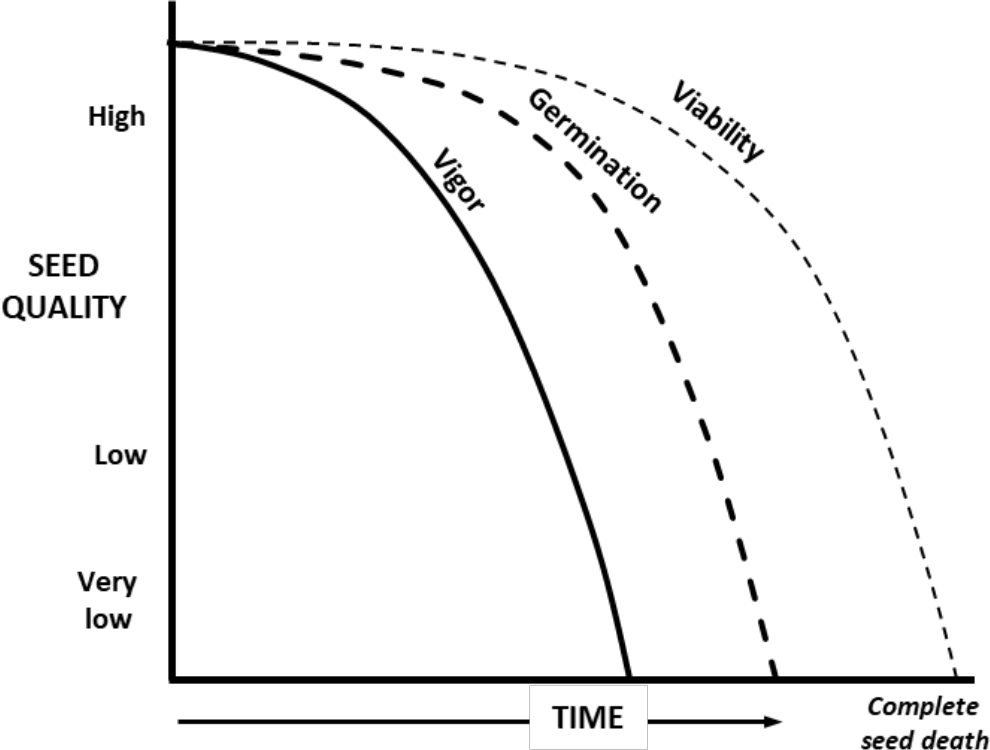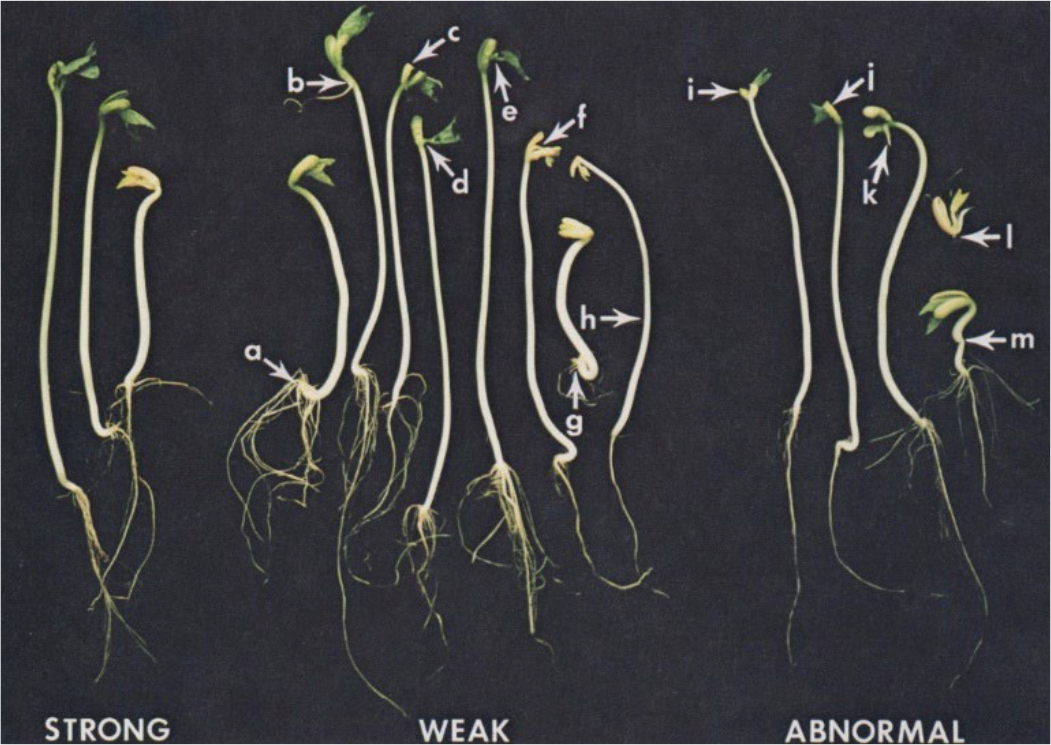⇦ Back to Crop Management Home
¶ Introduction
Germination is the seed analysis most commonly requested by seed producers. It is the accepted standard of seed quality and is used to set planting rates.
¶ What is Germination?
A germination test is run only on pure seed that remains after inert material, other crop seeds, and weed seeds have been removed from the seed sample. When a seed tag states "Germination – 95%", that does not mean that 95% of the contents of the bag or bin will germinate. It means that 95¾ of the pure crop seed found in the bag or bin will germinate under conditions found in the germination chamber.
Purity analysis is needed to determine what percentage of the seed lot is pure seed. Germination refers to the percentage of pure seed in a seed lot capable of producing normal, healthy seedlings under favorable conditions.
"Weak" seeds capable of producing normal seedlings are counted as live seeds. However, these seeds may not be able to produce normal seedlings under field conditions. Germination tests simply separate live seeds from dead seeds.
¶ How is Germination Analyzed?
The seed analyst first separates pure crop seed from inert material and other seeds. Pieces of seed larger than one-half the original size are considered whole seeds. Four separate replicates of 100 whole seeds each are prepared for germination testing.
Seeds must break dormancy in order to germinate. Dormancy can usually be broken by manipulating temperature and moisture. Some seeds require additional treatments to break dormancy, like prechilling or chemical treatment.
Not all seeds germinate under the same conditions, so length of the germination period and other conditions are different for each species.
Figure 1 gives basic testing conditions for some common seeds. Rules for seed testing specify the germination media (paper, sand, etc.), temperature required, length of testing period, and other suggestions.
Germination counts are made after the germination period is complete. Live seedlings must be normal in appearance and must not have any damaged or abnormal plant parts.
Abnormal seedlings are those that "sprout" and emerge, but have irregular or abnormal plant parts. They are counted as dead seeds because they are not capable of continued growth under normal conditions. Dead seeds are those seeds not capable of emerging.
Growers may run their own germination tests at home using a rolled cloth, blotter, sand, or soil. Standard germination results from a seed testing laboratory are different from results of "rag doll" germination tests done at home. Seeds that "sprout" 80% or greater will not always have a high standard germination and may not emerge well in the field.
¶ Table 1. Seed Germination Requirements |
|||
| Crop | Testing Period | Temperature | Other Requirements |
| Alfalfa | 7 days | constant 20°C | none |
| Bermudagrass, common | 21 days | constant 20 to 35°C | light, treat with NO3 |
| Brome, smooth | 14 days | constant 20 to 30°C | prechill for 5 days |
| Corn, field | 7 days | alternating 20° to 30° and 25°C | none |
| Sorghum, grain and forage | 10 days | constant 20 to 30°C | prechill for 5 days |
| Soybeans | 8 days | alternating 20° to 30° and 25°C | none |
| Sunflower | 7 days | constant 20 to 30°C | none |
| Wheat | 7 days | alternating 20° and 15°C | prechill for 5 days |
¶ Figure 1. Relative Decline of Seed Quality Factors Over Time

¶ Figure 2. Comparison of Strong, Weak, and Abnormal Seedlings

¶ Germination and Vigor
Seeds naturally begin to deteriorate after maturity. Speed of deterioration is affected by things like field weathering, storage conditions, and mechanical damage. Figure 2 illustrates three stages of seed deterioration. Seed vigor tends to decline before germination declines. The ability of seeds to germinate declines before viability declines.
Germination is the ability of a seed to germinate and develop a seedling that has the properly developed plant parts that are essential for establishment under nearly ideal conditions. A high germination percentage often indicates a high percentage of vigorous seeds. Seeds that germinate cannot necessarily establish seedlings under adverse conditions.
After germination ability declines, the seed is still viable or able to "sprout". However, a seed may still produce an abnormal seedling which lacks the normal plant parts needed to emerge and sustain growth under ideal conditions. When viability totally declines, the seed is dead.
Vigor is the ability of a seed to establish a seedling under adverse planting conditions. It is the first seed characteristic to decline. The germination percentage declines after vigor declines
¶ Normal and Abnormal seedlings
There are four morphological sites used to evaluate vigor:
- Root system.
- Hypocotyl (the embryonic axis between cotyledons and root).
- Cotyledons (storage tissue of reserve food for seedling development).
- Epicotyl (the embryonic axis above the cotyledons).
Figure 2 compare normal and abnormal seedlings from germination tests. Note that all seeds have sprouted and emerged, but not all have developed normally.
Seedlings are classified as ‘strong’ if the above four sites are well developed and free from defects. This indicates potential of satisfactory performance over a wide range of field conditions.
“Weak” or ”abnormal” seedlings have some deficiencies such as missing part of the root, one cotyledon missing, hypocotyl with breaks, lesions, necrosis, twisting, or curling, or malformed parts. These seeds cannot produce normal seedlings under the ideal conditions found in the germination chamber, so they cannot be expected to produce normal seedlings in the field.
The Association of Official Seed Analysts (ASOSA) have procedures that define standard conditions for germination. They also specify the appearance of normal seedlings and plant parts for each crop species. An untrained person often finds it difficult to distinguish between abnormal "sprouts" and normal seedlings. Approved seed technologists follow these procedures so test results will be consistent between laboratories from different areas.
¶ Hard Seed
Hard seed is a type of dormancy in which the seed has a coat that does not readily absorb water. Alfalfa, clovers, and other legumes are noted for hard seed. Live seeds that have not sprouted at the end of the germination period, but are hard and have not decayed are counted as hard seed. Dead seeds have decayed and are soft and mushy when pressed. The seed analyst makes no attempt to overcome hard seed in the laboratory. The percentage of hard seeds is reported with germination.
Germination and hard seed percentage should be added together to obtain percent live seed. Hard seeds are not "bad" seeds, but simply seeds with delayed germination. Their seed coats often deteriorate under field conditions, absorb water, and permit germination. Moderate delays in germination may be beneficial to help thicken a stand previously thinned by frost, insects, diseases, or drought.
Hard seeds are undesirable when they reduce a stand due to an excessive germination delay at normal seeding rates. They may also produce unwanted volunteer plants in the years fallowing seeding. Commercial seed processors try to overcome hard seed by scarifying (mechanically scratching) or etching seed coats with acid.